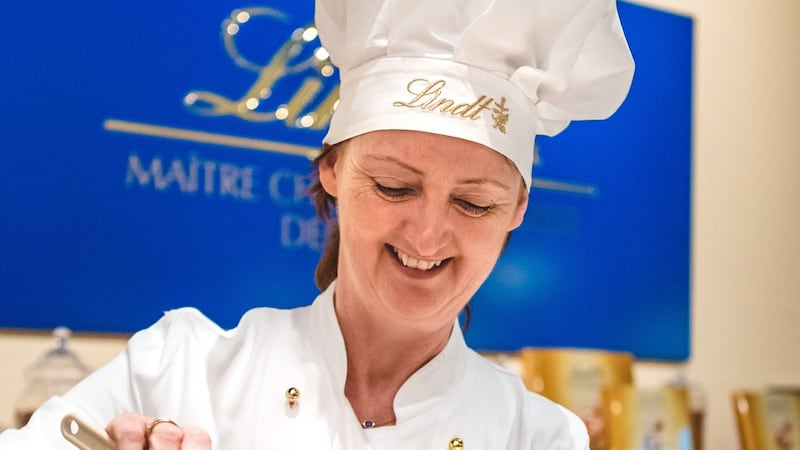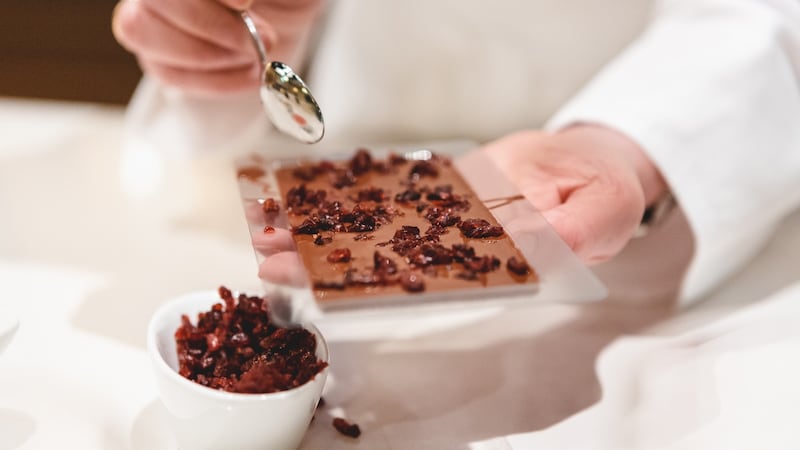“I like challenges, my nickname is Mission Impossible.”
Master chocolatier Stefan Bruderer is talking about one of the biggest challenges facing his industry at the moment – facing up to the sugar backlash. Working on ways of addressing that, as well as developing new chocolates for the world market, is part of his role at Lindt & Sprüngli, the Swiss confectionary company.
“My work space is 500 metres from here, in a hidden building, the research and development department,” he says. And he is not joking, chocolate production is a highly competitive process, and it wouldn’t do for me to stumble upon the next big thing during my visit to the factory in Kilchberg, a picturesque lakeside suburb of Zurich.
The darker the chocolate, the lower the sugar content, and at this factory they produce a bar in the Excellence range that has 99 per cent cocoa solids – leaving only 1 per cent for other ingredients. “So we actually have sugar-reduced chocolate,” Bruderer says, a trifle triumphantly.
It is true. But that 99 per cent cocoa bar does not have universal appeal. It is dry and does not melt easily in the mouth, a connoisseur’s chocolate. But there is a way to broaden its appeal, Bruderer tells me – pair it with whiskey, but not any old whiskey.
“If you have such a strong intense chocolate, then you need a whiskey with honey [flavours] and some sweetness.”
The former pastry chef, who leads a team of 16 master chocolatiers at Lindt, is an expert at matching chocolate with other flavours, in food and drinks.
“I try always to keep in mind that opposites attract. So if I have a very strong chocolate with a lot of polyphenols and tannins, I do not have a smokey whiskey, because the only sensory experience would be dryness in your mouth and you don’t want that.
“Another example is Excellence orange chocolate. This is a medium dark chocolate and it is quite sweet. There is a very ripe aroma profile of sundried oranges. For that I go for a dry white wine with some acidity and fruit notes, not ripe fruit notes, but notes like green apple, pineapple and grapefruit.”
This pairing, he says, works because it is in balance. “So you can taste two different things, and together you create a third taste, something completely new.”
Rules for enjoyment
Whatever chocolate it is you are indulging in, there are some rules Bruderer suggests to maximise your enjoyment.
“People who eat chocolate straight out of the fridge don’t really like chocolate, because the chocolate does not get time to melt and set the flavours free. Chocolate out of the fridge is less intense because you have swallowed it before it is completely melted.”
How we eat it also matters, it seems. “Put a piece in you mouth and let it melt slowly, and of course it is very important to breathe the right way – in through your mouth and out through the nose, because if you do, you can transport the flavours of the melted chocolate to the taste buds behind the nose [retro-nasal].”
Science bit done, it is time to dress up and get to play chocolatier, an activity that is open to visitors to the factory, who can book a variety of two-hour classes (€65) in the company’s purpose-built Chocolateria.

In 2020 the Chocolateria will move to a Chocolate Competence Centre that is under construction at the factory site, that will include an interactive chocolate museum, as well as a cafe and shop. There is currently a spacious shop, with factory seconds as well as a vast range of international product lines, a few moments walk from the factory.
Before reporting to the master chocolatier assigned to your class, get some assistance adjusting your toque, or chef’s hat, is the first advice I can share – it’s not straightforward, and a floppy toque is not a good look.
Lessons
The workshop might begin with an insight into the three different types of cocoa beans – criollo, trinitario and forastero – together with information on where Lindt sources them from and how they use them. The three main stages of chocolate production – fermentation, roasting and conching – are also covered before you get to dip into the giant pots of tempered chocolate on each workbench.
The most popular classes cover the making of filled chocolates or praline, but I am tasked with a simpler job, filling moulds with just enough of the liquid chocolate (without making a mess), before topping the bars with my choice of additional ingredients.
“Less is more,” Bruderer cautions, as I assiduously try to cover every inch of my bars with cranberries, hazelnuts and caramel pieces. Not all together, but separately, the caramel bar topped with the merest hint of fleur de sel.

It’s not uncommon for class participants to try to use all seven additional ingredients – two types of caramel (light and dark), freeze dried raspberries, fleur de sel, cranberries, hazelnuts and candied almond slivers – in one bar. But I get the feeling that while this is indulged, it’s not the smartest choice.
Just 30 minutes later, my first handcrafted customised Lindt chocolate bar is ready to be wrapped and sealed – and then eaten, with a resounding snap, like Bruderer tells me well-tempered chocolate should.
Lindt master chocolatier Ernst Flury will be at the Lindt display stand at Taste of Dublin (June 14th-17th), demonstrating how to make and fill Lindor truffles. There will also be the biggest variety of products the company has ever showcased in Ireland, available for tasting and purchase.











